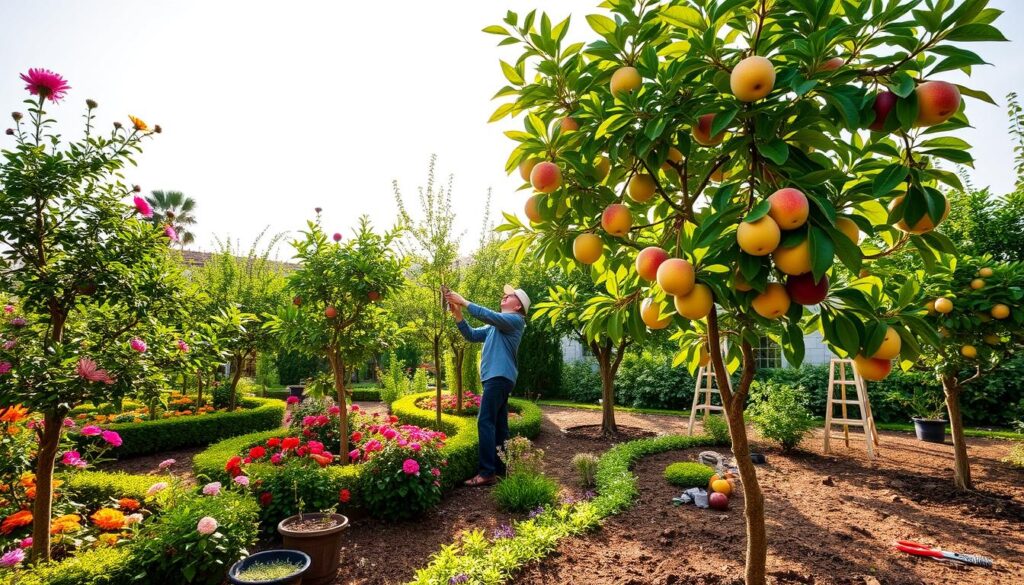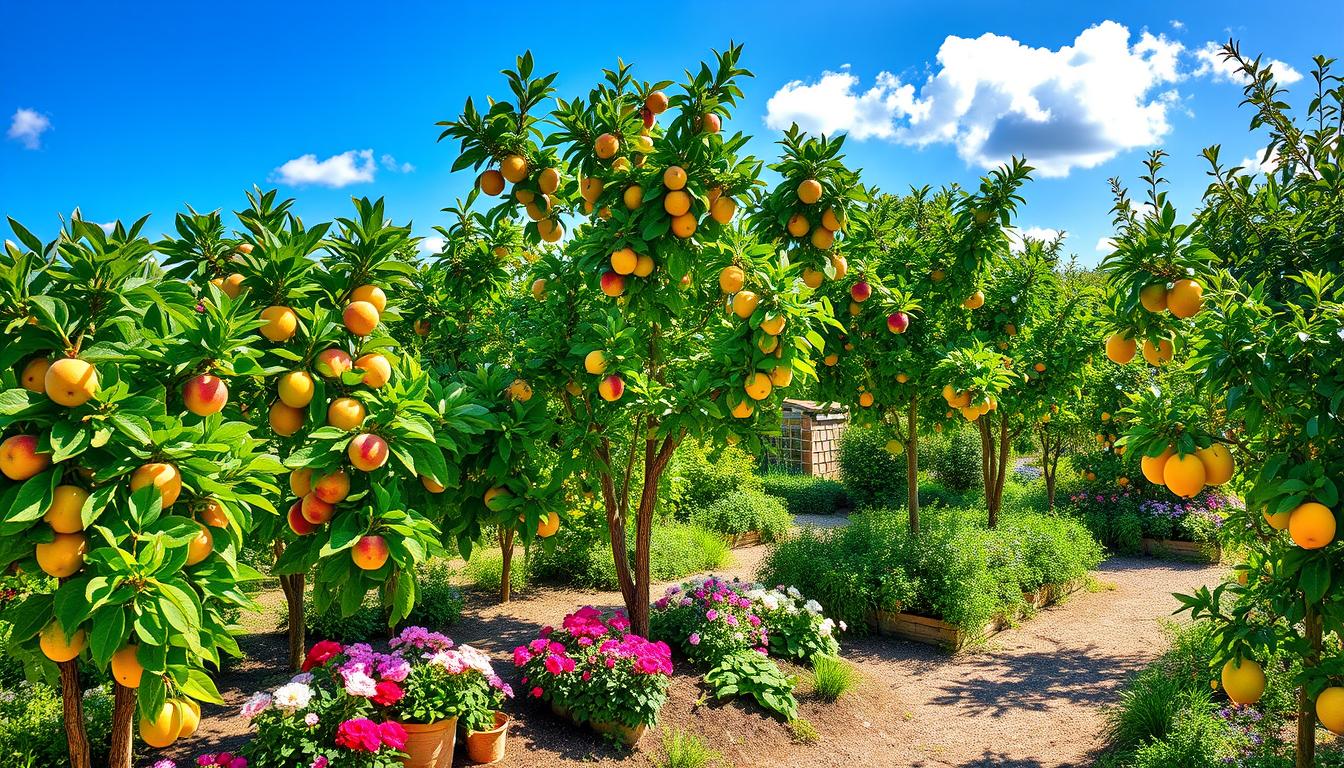Choosing the right fruit trees is key for small outdoor spaces. Dwarf and compact fruit trees let homeowners grow fresh produce without needing a lot of land. This article will explore the benefits of these trees, help pick the best for your space, and offer tips for small gardens.
Dwarf apple trees grow only 8-10 feet tall, unlike their bigger versions. Dwarf cherry trees reach 6-8 feet. Many fruits can grow well in small gardens. I’ll share picks like the Montmorency cherry and Bartlett pear for a fruitful tiny space.
Let’s look at the top fruit trees for small gardens and how they can change your gardening.
Key Takeaways
- Dwarf fruit trees allow for fresh produce in limited spaces.
- Varieties like dwarf apple and peach trees thrive in small gardens.
- Container gardening provides flexibility for urban environments.
- Regular pruning helps maintain size and enhances fruit production.
- Choosing self-pollinating varieties maximizes yields in small areas.
Understanding the Benefits of Dwarf and Compact Fruit Trees
Dwarf and compact fruit trees are perfect for gardeners with little space. They grow to be about 8 to 10 feet tall, making them easy to care for. They also start producing fruit quickly, often in just 3 to 4 years.
This fast fruit production adds excitement to gardening. It’s especially important in small spaces or cities. Dwarf trees can even grow in containers, making the most of your space.
These trees also make your garden look and feel better. They bloom beautifully and attract helpful insects. Plus, their fruit is often bigger and tastier than what you’d find on bigger trees.
As I plan my garden, I see how valuable these trees are. They offer quick harvests and can grow well in tight spots. They’re a smart choice for anyone who wants to grow their own food.
The Importance of Selecting the Right Variety for Small Spaces
Choosing the right fruit tree for small spaces is crucial. Some trees grow too big for compact gardens. I choose dwarf and semi-dwarf varieties for my garden. They grow up to 10 feet tall and 8 to 10 feet wide, making them easy to care for.
Dwarf fruit trees start producing fruit quickly. They can bear fruit in 4 to 5 years, unlike standard apple trees that take 7 to 10 years. This is great for small garden lovers who want fresh fruit fast.
- Maintaining smaller fruit trees is manageable even for novice gardeners.
- Dwarf varieties often produce fruit that is perfectly sized for small hands, catering to the growing demand for kid-sized snacks.
- Annual pruning and thinning enhance both size and productivity, ensuring minimal space is maximized.
It’s important to know what these trees need. They need 6 to 8 hours of sunlight a day. Some trees, like crabapples and elderberries, can handle shade. They also need temperatures between 55 and 85 degrees Fahrenheit.
By carefully picking fruit trees for small gardens, gardeners can make their spaces productive. They can grow delicious fruits without taking up too much space.
Best Fruit Trees for Small Gardens
Choosing the right fruit trees for small gardens is key. Dwarf trees fit well in tight spaces and produce lots of fruit. Here are some top picks for compact gardens.
Dwarf Apple Trees
Dwarf apple trees grow to about six to eight feet tall. ‘Cameron Select’ produces bright red apples in September. ‘Honeycrisp’ is loved for its sweet taste. They’re great for small gardens.
Semi-Dwarf Peach Trees
Semi-dwarf peach trees like ‘Belle of Georgia’ grow 10 to 12 feet tall. They produce lots of sweet, white fruit. They’re perfect for small spaces, making them ideal for semi-dwarf peach trees.
Dwarf Cherry Trees
Dwarf cherry trees like ‘Stella’ and ‘Montmorency’ grow six to eight feet tall. They bloom beautifully in spring and taste delicious. Their small size adds charm to small gardens.
Compact Lemon and Fig Varieties
Compact lemon trees like Meyer lemons grow four to six feet tall. They produce fragrant, tasty fruits. Fig varieties like ‘Celestial’ are great for containers, growing up to ten feet tall. They’re perfect for adding beauty to patios and small gardens.

Tips for Growing Fruit Trees in Small Gardens
Growing fruit trees in small gardens can be tricky, but with the right approach, it’s rewarding. Container gardening lets me arrange plants for the best sunlight or easy access. Choosing self-pollinating trees makes it easier to grow a lot without needing many trees.
Choose Container Gardening for Flexibility
Container gardening uses space well and lets me move plants as needed. It helps ensure my trees get enough light without blocking each other. Containers also help with drainage and soil, which is key for healthy trees.
Select Self-Pollinating Varieties
Self-pollinating fruit trees make gardening simpler. They can produce fruit on their own, without needing another tree. Apple, pear, and cherry trees are good choices for small spaces and give lots of fruit. For a list of dwarf fruit trees, check out growing dwarf fruit trees.
Regular Pruning to Maintain Size
Pruning trees regularly helps control their size and health. It keeps my garden neat and productive. Prune in late winter or early spring to shape the trees and boost fruit. Regular pruning keeps them manageable and fruitful.
| Tree Variety | Height | Pollination Type |
|---|---|---|
| Dwarf Apple | 8-15 feet | Self-Pollinating |
| Semi-Dwarf Peach | 8-12 feet | Self-Pollinating |
| Dwarf Fig | 6-15 feet | Self-Pollinating |
| Dwarf Cherry | 6-10 feet | Self-Pollinating |
GardenBeginner.com has great resources for gardeners. These tips help me grow fruit trees in my small garden and enjoy their fruits every year.
Popular Dwarf Fruit Tree Varieties
In small gardens, dwarf fruit trees are a hit. They produce tasty fruits and don’t take up much space. Gardeners love them for their compact size and fruitful yields.
Dwarf Pear Trees
Dwarf pear trees like ‘Bartlett’ and ‘Shinseiki’ offer sweet, juicy pears. They grow up to 10 feet tall and do well in Zones 3-10. Their small size is perfect for city gardens or tight spaces, letting me pick fresh pears from my yard.
Semi-Dwarf Plum Trees
Semi-dwarf plum trees, like ‘Stanley,’ fit well in smaller areas. They grow to about 10 feet tall and do best in Zones 4-9. They’re not just good for plums; they also beautify any garden with their blooms and fruit.
Urban-Friendly Citrus Trees
Urban-friendly citrus trees, like dwarf Meyer lemon and calamondin orange, brighten up small spaces. They can grow up to 15 feet tall and thrive in Zones 9-11. These trees are great for containers, making them perfect for patios or balconies. Their colorful fruits and leaves add joy to my gardening.
Caring for Your Small Space Fruit Trees
Proper care is key for small-space fruit trees to thrive. They need the right amount of sunlight and water. Also, the soil must be prepared correctly.
Providing Adequate Sunlight and Water
Sunlight is crucial for fruit trees. I make sure they get at least six hours of sunlight daily. This helps them grow well and produce fruit.
Watering them regularly is also important, especially when it’s dry. Deep watering helps the roots grow strong. This makes the trees more drought-resistant and better at using water.
Soil Preparation and Fertilization
Choosing the right soil is the first step in growing small fruits. I pick soil that drains well and is full of nutrients. This helps the roots grow strong and the trees produce more fruit.
Fertilizing during the growing season gives the trees the nutrients they need. Mulching is another trick I use. It keeps the soil moist and stops weeds from growing, creating a perfect spot for my fruit trees to grow.

For more information about the privacy of user data, please refer to this privacy policy.
Design Tips for Integrating Fruit Trees into Small Gardens
Adding fruit trees to gardens brings beauty and usefulness, especially in small spaces. Placing them wisely saves room and makes picking fruit easy. Using vertical gardening lets trees grow up walls or fences, saving space and looking great.
Vertical Gardening Techniques
Vertical gardening is a smart way to fit fruit trees into tight spots. Trellises or arbors support climbing trees, creating a beautiful sight. Dwarf fruit trees, growing 10-12 feet tall, work well for this, making gardens look good and work well.
Utilizing Edges and Pathways
Putting fruit trees along garden edges or paths makes them easy to reach and saves space. This setup keeps the garden neat and lets trees grow well. Paths wide enough for wheelbarrows help move around trees easily. This way, my garden stays useful and pretty, full of fruit.
Combining Fruit Trees with Other Plants
Adding other plants to your fruit trees makes your garden healthier and more beautiful. This method boosts yields and builds a balanced ecosystem. I’ve seen how different plants together can achieve amazing results.
Companion Planting for Healthier Growth
Companion planting means placing plants together to help them grow better. For example, daffodils near fruit trees keep pests away and add color. Chives at the garden’s edge keep insects off other plants.
Dill attracts good bugs that help pollinate. These plants work together to create a strong garden.
Creating an Attractive Garden Layout
A good layout makes your fruit tree garden look great. I mix plants of different heights and colors for a lively look. I place plants where they get the right sunlight and water.
This way, each plant does well, making a strong garden. Echinacea, for instance, looks good and helps fruit trees by making nutrients available.
Growing Fruit Trees on Patios and Balconies
Growing fruit trees on patios and balconies is a great idea for city gardeners with little space. Choosing the right containers helps trees grow well and look good. Even with a small space, you can grow many different fruits.
Choosing the Right Containers
Choosing the right container is key for growing fruit trees on balconies. A container should be at least 30cm (12in) wide to fit the roots. Good choices include galvanized dustbins, halved wooden barrels, and terracotta pots.
Lightweight containers make it easy to move them around. This helps trees get the right amount of sunlight and weather.
Best Practices for Patio Gardening
Patio gardening needs careful watering, feeding, and pruning. Feed your fruit trees with balanced fertilizers in spring and summer. This keeps them healthy.
Blueberries need acid soil and should drink rainwater, not tap water. Prune fruits in July to help them grow better. These steps help your trees grow well and produce lots of fruit.
For more tips on picking and caring for patio fruit trees, see this guide: Patio Fruit Garden Guide.
Conclusion
Creating a fruitful oasis in small gardens, patios, and balconies is possible. The right approach makes it easy. I’ve found many dwarf and compact fruit trees that grow well in small spaces.
These trees give us delicious homegrown fruits. For example, fig trees like Brown Turkey are easy to care for. Cherry trees are also great, as they resist diseases well.
Knowing how to care for these trees is key. Peach and apricot trees need regular pruning. Cherry trees, on the other hand, are low maintenance.
Choosing the right tree for your climate and taste is crucial. You can grow Asian pears or blackberries in your small garden. There’s a tree for every gardener’s needs.
Adding these trees to your garden makes it beautiful and sustainable. It becomes a place where you can grow your own fruits. I suggest trying out different dwarf and compact fruit trees. Turn your small outdoor space into a fruitful paradise.



Leave a Reply